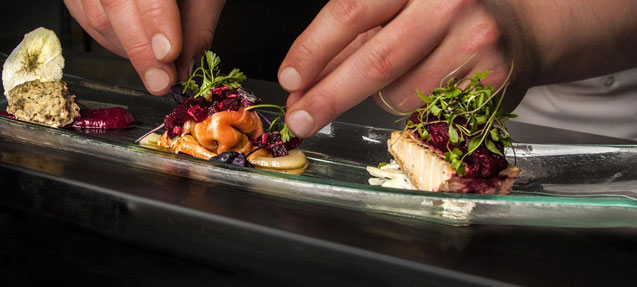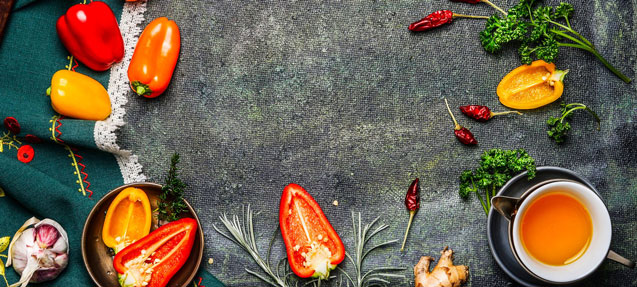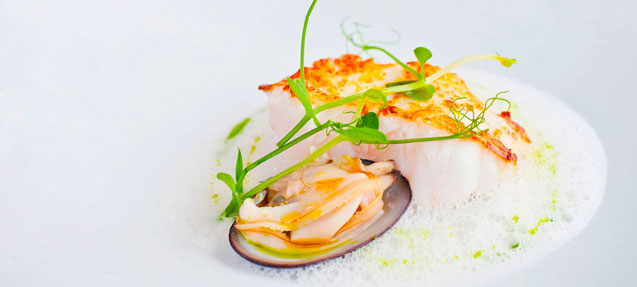Let's go "de Tapas"

These are some of the most typical tapas you may be served along with a drink or that you can order when eating a tapas meal.
- Spanish omelette: This is often ordered as a pincho de tortilla, or a piece of tortilla. The most traditional ones are made with eggs, potatoes and olive oil, but many also contain onion.
- Patatas bravas and patatas alioli: These are fried potatoes covered in a tasty sauce. Bravas sauce is spicy and alioli is made mainly from olive oil and garlic.
- Cured ham: And if it is Iberian, even better. This is one of the Spanish products most-liked by visitors and as a tapa is usually served with bread or picos and colines (small dish of crunchy bread typical in Spain).
- Cheese: In Spain there are many varieties and you will most typically be offered a local cheese. Some of the most well-known are Manchego (typical of Castilla – La Mancha), Idiazábal (Basque Country), Roncal (Navarre), Mahón (Balearic Islands) and Majorero (Canary Islands).
- Olives: Olives are usually served pickled. In fact, pickled items in general are commonly found in tapas. There are also stuffed olives (normally with anchovies or peppers).
- Calamari: Battered squid fried in olive oil and served hot. They are popular all over the country, especially cut into rings.
- Croquettes: Although ham croquettes are the most traditional type of croquette, you can also increasingly find them made with wild mushrooms, king crab, squid, prawns, cod or different types of strong cheeses, like Cabrales.
- Mussels: These are mainly steamed and can be served with lemon or with finely-chopped and dressed tomato, onion and pepper.
- Pan tumaca: Bread, tomato, olive oil, garlic (optional) and salt. This is typical in Catalonia, where it is also known as pa amb tomàquet. Depending on tastes, ham, cured meats, tortilla or cheese may be added.
- Black pudding and chorizo: Together with ham, these are two of the most popular cured pork products served as tapas. The first is made with rice and the second is served grilled or cooked in cider. Other popular pork tapas include picadillo(chopped and breaded meat), and chicharrones and torreznos, made mainly from fat.
- Gilda: This is a classic from the Basque country, where tapas are called pintxos. It is a skewer with an anchovy, olive and hot pepper.
- Huevos rotos: Also known as huevos estrellados, these are fried eggs with a runny yolk served over a bed of ham and fried potatoes. The yolk is broken up and runs over the other ingredients. It is usually served with bread to dip into the egg yolk. There are other popular versions which substitute the ham for baby eels, prawns or other cured pork products.
- Cuttlefish: Served grilled with mayonnaise or alioli sauce In many places, fried chopitos (similar to cuttlefish but smaller in size)are popular, which in Andalusia are known as puntillitas.
- Paella: The most popular dish in the Valencia region. Its main ingredient is rice and it is made with vegetables and, depending on the type, with meat or seafood.
- Octopus a feira: Octopus is often served on a wooden board in Galicia. This is why it is known as pulpo a la gallega. It is served boiled and chopped, seasoned with salt and paprika and drizzled with olive oil.
- Papas arrugadas: You can try these potatoes above all in the Canary Islands, where they are served with mojo (a sauce from the region with a rich flavour). The most famous type is made with small local potatoes which are boiled and covered in salt.
- Pescaíto frito: Fresh battered fish fried in olive oil. This is found mostly in Andalusia where it is often served in a paper cone, prepared with a flavourful spice mix. There it is also known as bienmesabe.
- Ensaladilla: This is a cold dish prepared with boiled potatoes, mayonnaise, tuna, egg and various finely-chopped vegetables and pulses, such as carrots, peas or green beans.
- Migas: Its main ingredient are bread crumbs fried in olive oil and various other ingredients to give the dish flavour. These can include chorizo, bacon, peppers, garlic, onions, etc. There are many varieties, with some adding grapes, others substituting meat for cod fish, etc.
- Salmorejo and gazpacho: Two typical cold soups from Andalusia, usually served in the summer. Tomatoes and olive oil are the main ingredients.
- And to drink? The most popular drinks are beer and wine. Also common are cider, vermouth and sangria. Beer is often served in a caña (20 cl. glass) but can also be a doble (double the quantity), quinto or botellín (20 cl. bottle), or jarra (half litre). Lager is the most popular beer. As for wine, the most well-known is Rioja, but make sure you sample other varieties, since all regions in Spain produce delicious Designation of Origin wine.
Flavours of Spain to take home

We recommend Spanish gastronomic products to take home because of their taste, their aroma, and because they are healthy.
- Extra virgin olive oil: Spain is the main producer in the world. A simple and tasty way to try it is to drizzle it over crunchy bread. Also in salad dressings and on grilled vegetables.
- Iberian cured ham: It is an exclusive Spanish food and there are four designations of origin: Guijuelo (from Salamanca and Extremadura), Dehesa de Extremadura (in the region of Extremadura) and Los Pedroche and Jamón de Huelva (both in Andalusia). If you want to take it home, the best option is to vacuum-pack it. How to eat it? Try it like tapas with a beer or glass of wine.
- Wines: The most international is Rioja, although other Spanish wines are gradually gaining more recognition. Although quality wine is produced all over Spain and more and more is being exported.
- Cheeses: You will find very tasty local products all over Spain. Perhaps the most popular on an international level is Manchego cheese (from Castile-La Mancha). However, the list is enormous and satisfies all tastes.
- Regional products: These are the most typical products of each destination and it is best to buy them in local shops. Good examples are ensaimadas from the Balearic Islands, fabes beans from Asturias and mojo sauces from the Canary Islands. The most notable sweet treats are marzipan from Toledo (Castile-La Mancha) and turrones from the Region of Valencia (both products are easy to find all over Spain at Christmas).
- Savoury snacks: Conserves from the north (especially anchovies from Cantabria), olives (the ones from Jaén in Andalusia are very popular) and conserves of vegetables, such as asparagus from Navarre, Piquillo pepper from Lodosa and aubergines from Almagro are the savoury products that stand out.
- Liqueurs: In some areas, the herbal and orujo liqueurs such, as Pacharán de Navarra, Orujo de Galicia and herbal liqueurs from Ibiza and Mallorca are very well-known.
Delicious, Healthy, and 100% Spanish

Spanish food is a showcase for the Mediterranean diet: Healthy food, olive oil, vegetables, and seasonal ingredients.
The culinary getaways Spaniards love

Spanish people love good food, and Spain is full of destinations perfect for the discerning foodie. Listed are places that are worth a trip for their culinary traditions and special dishes alone. As well as the delicious tapas you can enjoy anywhere in Spain, we have 17 foodie getaway suggestions for you:
- Wine tasting in La Rioja and La Rioja Alavesa
- Pintxos in Donostia-San Sebastián
- Suckling lamb in Aranda de Duero
- A volcano in your glass? (Don’t worry, we’re just talking about the vineyards of La Geria in Lanzarote, one of the volcanic Canary Islands.)
- Tuck into a calçotada in Catalonia
- A Galician spell to keep evil at bay - The spell is recited over the queimada, a drink based on marc, with a ritual preparation designed to ward off evil spirits.
- The only cider in the world poured from a height in Asturias
- Food markets, espcially the most famous, the Boquería, in the heart of Barcelona
- The art of skewering sardines on the Costa del Sol
- Keeping the cold out with cocido in Madrid
- Queso Manchego in Castilla-La Mancha
- A sea of olive groves in Jaén
- Paella by the sea in Valencia
- The Iberico Ham Route in Extremadura
- The best caldereta de langosta in Menorca
- Chestnuts for All Saints - Castanyada in Catalonia, amagüestu in Asturias, magosta in Cantabria, gaztainerre in the Basque Country, chaquetía in Extremadura, magosto in Galicia - Festivals - in celebration of All Saints’ Day held on November 1st
- The restuarants with 3 Michelin stars




